engine BUICK REGAL 1993 Owners Manual
[x] Cancel search | Manufacturer: BUICK, Model Year: 1993, Model line: REGAL, Model: BUICK REGAL 1993Pages: 308, PDF Size: 16.35 MB
Page 6 of 308
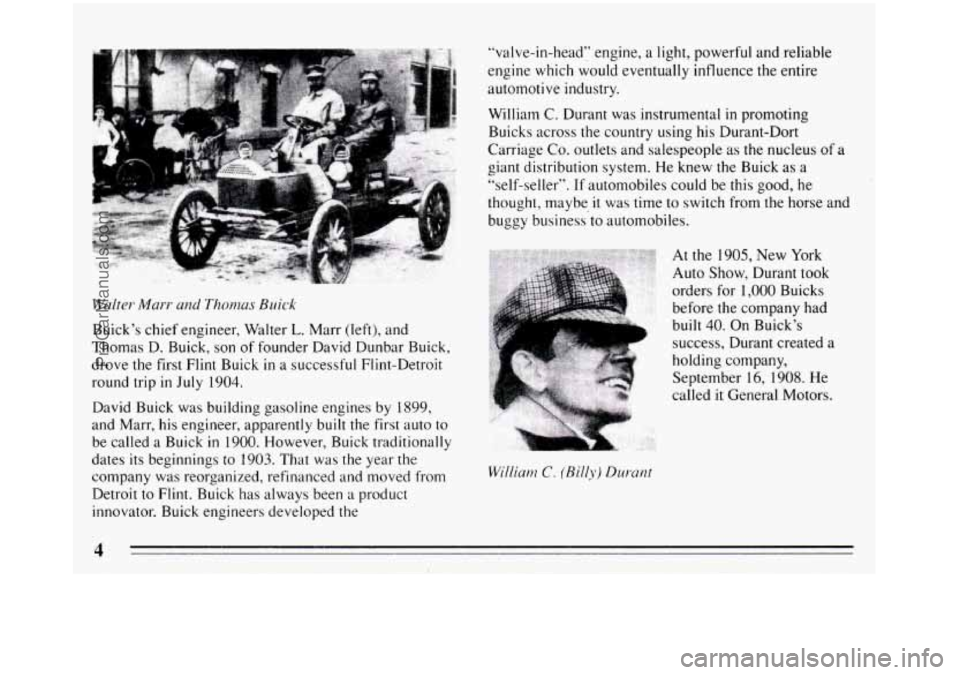
Walter Marr and Thomas Buick
Buick’s chief engineer, Walter L. Marr (left), and
Thomas D. Buick, son of founder David Dunbar Buick,
drove the first Flint Buick in a successful Flint-Detroit
round trip
in July 1904.
David Buick was building gasoline engines by 1899,
and Marr, his engineer, apparently built the first auto to
be called a Buick in 1900. However, Buick traditionally
dates its beginnings to 1903. That was the year the
company was reorganized, refinanced and moved from
Detroit to Flint. Buick has always been a product
innovator. Buick engineers developed the “valve-in-head”
engine, a light, powerful and reliable
engine which would eventually influence the entire
automotive industry.
William
C. Durant was instrumental in promoting
Buicks across the country using his Durant-Dort
Carriage
Co. outlets and salespeople as the nucleus of a
giant distribution system. He
knew the Buick as a
“self-seller”. If automobiles could be this good, he
thought, maybe it was time to switch from the horse and
buggy business.to automobiles.
Willianz C. (Billy) Durant
4
ProCarManuals.com
Page 7 of 308
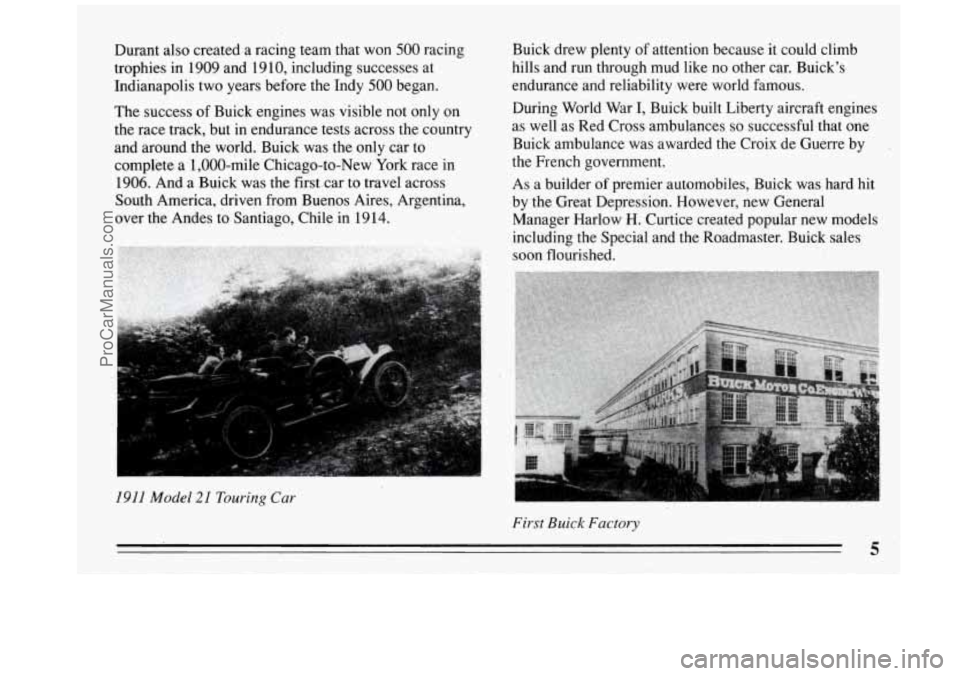
Durant also created a racing team that won 500 racing
trophies in 1909 and 1910, including successes at
Indianapolis two years before the Indy
500 began.
The success of Buick engines was visible not only on
the race track, but in endurance tests across the country
and around the world. Buick was the only car to
complete a
1,000-mile 'Chicago-to-New York race in
1906. And a Buick was the first car to travel across
South America, driven from Buenos Aires, Argentina,
over the Andes
to Santiago, Chile in 19 14.
19II,Model21 Touring Car
Buick drew plenty of attention because it could climb
hills and run through mud like no other car. Buick's
endurance and reliability were world famous.
During World War
I, Buick built Liberty aircraft engines
as well as Red Cross ambulances
so successful that one
Buick ambulance was awarded the Croix de Guerre by
the French government.
As a builder
of premier automobiles, Buick was hard hit
by the Great Depression. However, new General
Manager Harlow
H. Curtice created popular new models
including the Special and the Roadmaster. Buick sales
soon flourished.
First Buick Factory
5
ProCarManuals.com
Page 8 of 308
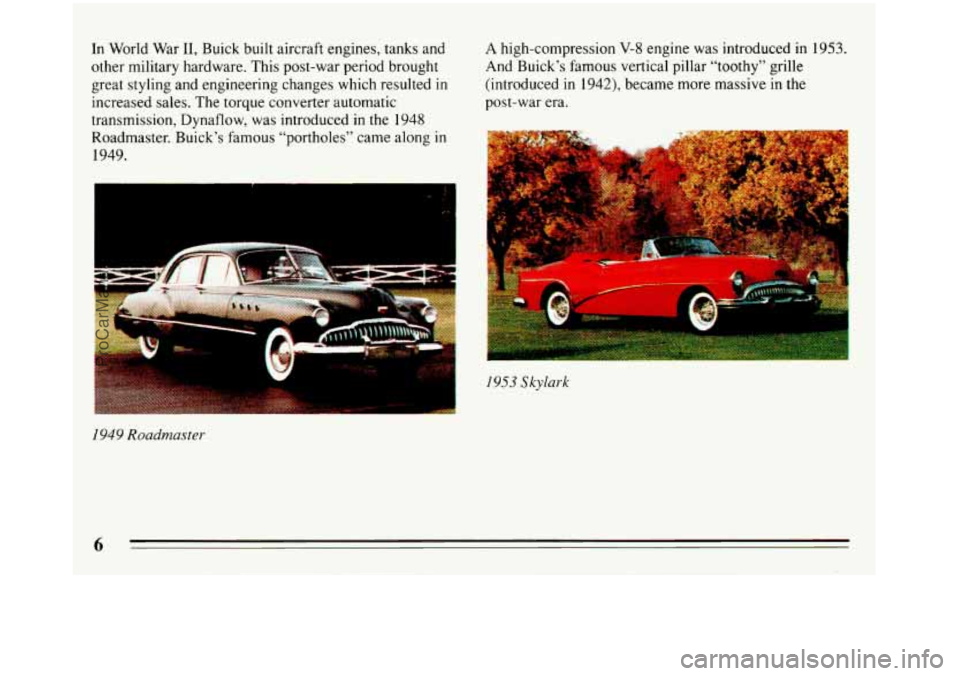
In World War 11, Buick built aircraft engines, tanks and
other military hardware. This post-war period brought
great styling and engineering changes which resulted
in
increased sales. The torque converter automatic
transmission, Dynaflow, was introduced in the
1948
Roadmaster. Buick’s famous “portholes” came along in
1949.
A high-compression V-8 engine was introduced in 1953.
And Buick’s famous vertical pillar “toothy” grille
(introduced in
1942), became more massive in the
post-war era.
I953 Skylark
I949 Roadmaster
6
ProCarManuals.com
Page 9 of 308
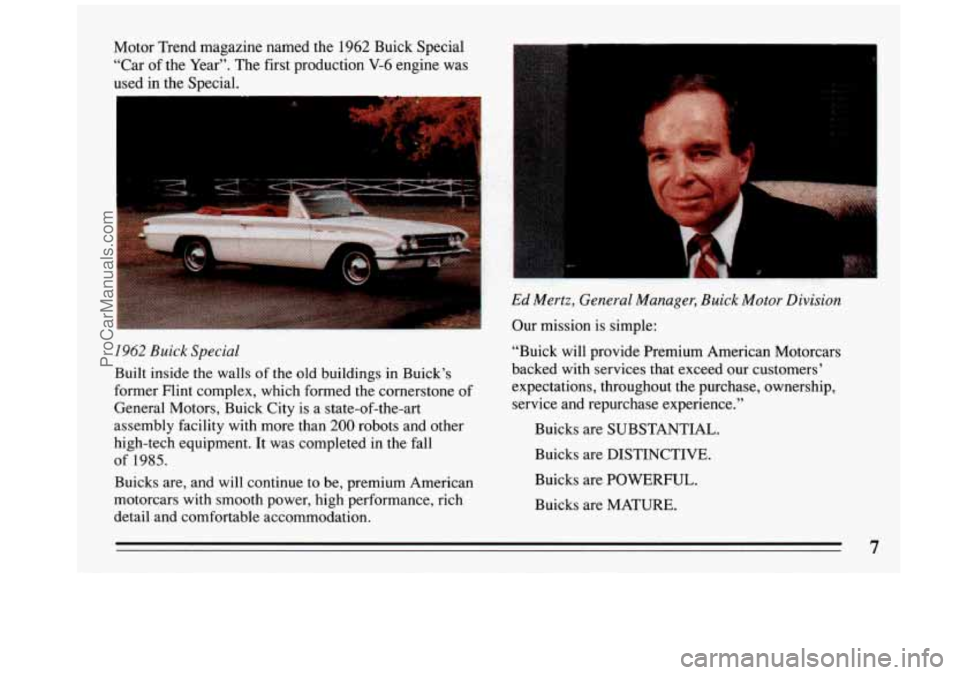
Motor Trend magazine named the 1962 Buick Special
“Car of the Year”. The first production V-6 engine was
used
in the Special.
’
-r’
I962 Buick Special
Built inside the walls of the old buildings in Buick’s
former Flint complex, which formed the cornerstone of
General Motors, Buick City is
a state-of-the-art
assembly facility with more than
200 robots and other
high-tech equipment. It was completed in the fall
of
1985.
Buicks are, and will continue to be, premium American
motorcars with smooth power, high performance, rich
detail and comfortable accommodation.
I .. .
.. ...
Ed Mertz, General Manager, Buick Motor Division
Our mission is simple:
“Buick will provide Premium American Motorcars
backed with services that exceed our customers’
expectations, throughout the purchase, ownership,
service and repurchase experience.”
Buicks are SUBSTANTIAL.
Buicks are DISTINCTIVE.
Buicks are POWERFUL.
Buicks are MATURE.
7
ProCarManuals.com
Page 11 of 308
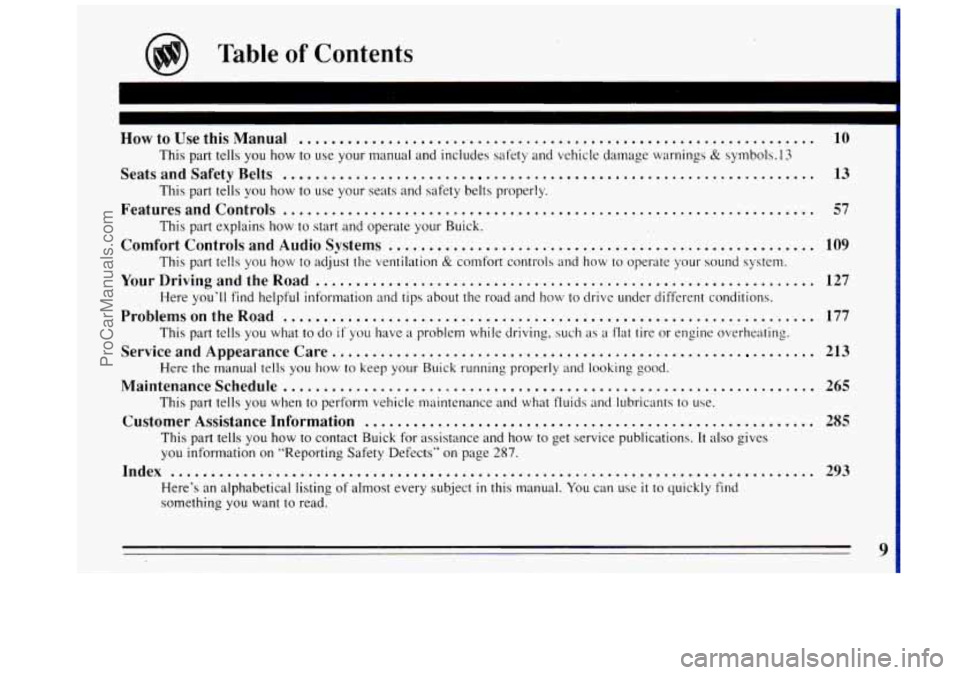
HowtoUsethisManual ................................................................ 10
Seats and Safety Belts
. . . . . . . . . . . . . . . . . . . . . . . . . . . . . . . . . . . . . . . . . . . . . . . . . . *. . . . . *. . . . . . . . 13
FeaturesandControls
.................................... ............................... 57
Comfort Controls and Audio Systems . . . . . . . . . . . . . . . . . . . . . . . . . . . . . . . . . . . . . . . . . . . . . . . . I.. . I 109
YourDrivingandtheRoad
.............0.0..........s...................................... 127
ProblemsontheRoad
.................................................................. 177
Service and Appearance Care..
. . . . . . . . . . . . e . . . . . . . . . . . . . . . . . . . . . . . . . . . . . . . . . . . . . . . . . . 213
Maintenanceschedule
.................................................................. 265
Customer Assistance Information
. . . . . . . . . . . . . . . . . . . . . . . . . . . . . . . . . . . . . . . . . . . . . . . . . . . . . . . . 285
This part tells you how to use your manual and includes safety and vehicle damage warnings & symbols. 13
This part tells you how to use your seats and safety belts properly.
This part explains how
to start and operate your Buick.
This part tells you how to adjust the ventilation
& comfort controls and how to operate your sound system.
Here you’ll find helpful information and tips about the road and how
to drive under different conditions.
This part tells you what
to do if’ you have a problem while driving, such as a flat tire or engine overheatins.
Here the manual tells you how to keep your Buick running properly and looking good.
This part tells you when
to perf’orm vehicle maintenance and what fluids and lubricants to use.
This part tells you how to contact Buick for assistance and how
to get service publications. It also gives
you information on “Reporting Safety Defects” on page
287.
Here’s an alphabetical listing of almost every subject in this manual. You can use it to quickly find
something you want to read.
Index ........................................................................\
........ 293
9
ProCarManuals.com
Page 14 of 308
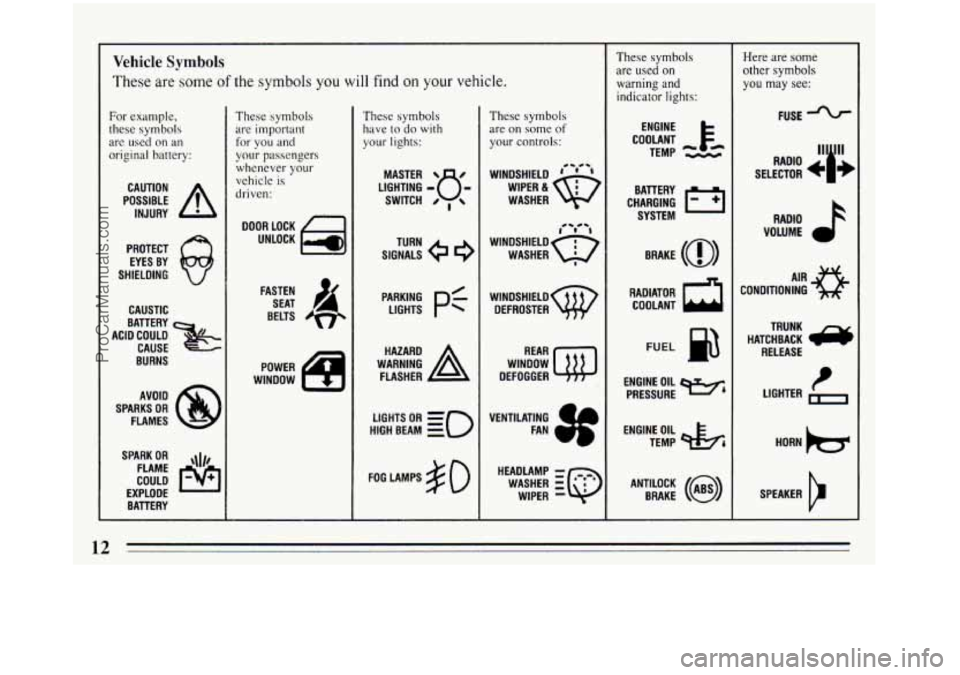
Vehicle Symbols
These are some of the symbols you will find on your vehicle.
For example,
these symbols
are used on an
original battery:
POSSIBLE A
CAUTION
INJURY
PROTECT EYES BY
SHIELDING
CAUSTIC
BURNS AVOID
SPARKS
OR
FLAMES
SPARK
OR ,\I/,
COULD FLAME
EXPLODE BATTERY
These symbols
are important
for you and
your passengers
whenever your
vehicle
is
driven:
DOOR LOCK
UNLOCK
e
e
BELTS 4
POWER
WINDOW
These symbols
have
to do with
your lights:
SIGNALS e @
TURN
HIGH BEAM
OR = =o
FOG LAMPS $0
These symbols
are on some
of
your controls:
WINDSHIELD ' ' ' 0- 0-
WASHER
WINDSHIELD WASHER
WINDOW
DEFOGGER
VENTILATING FAN
HEADLAMP
-
WIPER
WASHER
Q
These symbols
are
used on
warning and
indicator lights:
COOLANT F-
TEMP --
ENGINE
CHARGING
I-1
BATTERY SYSTEM
BRAKE
(0)
RADIATOR 0
COOLANT
FUEL
ENGINE OIL w,
PRESSURE
TEMP
OIL &b
ANTILOCK (a)
BRAKE
Here are some
other symbols
you may see:
FUSE
RADIO
VOLUME
CONDITIONING
AIR 43
HATCHBACK TRUNK
RELEASE
t LIGHTER
HORN
SPEAKER
12
ProCarManuals.com
Page 59 of 308
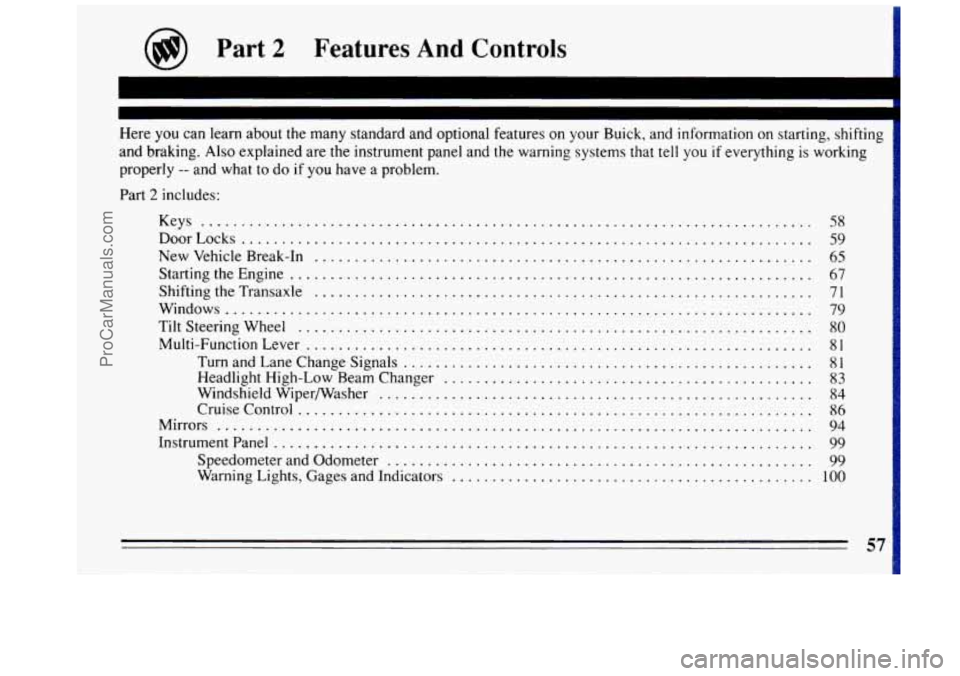
'art 2 Features And Controls
Here you can learn about the many standard and optional features on your Buick. and information on .. starting. shifting ..
and braking . Also explained are the instrument panel and
properly
.. and what to do if you have a problem .
Part 2 includes: the warning
systems that tell you
if every
Thing is working
Keys ........................................................................\
....
DoorLocks ....................................................................... \
NewVehicleBreak-In ..............................................................
StartingtheEngine .................................................................
ShiftingtheTransaxle ..............................................................
Windows ........................................................................\
.
TiltSteeringWheel ................................................................
Multi-FunctionLever ...............................................................
TurnandI, aneChangeSignals ...................................................
Headlight High-Low Beam Changer ..............................................
WindshieldWiper/Washer ......................................................
Cruisecontrol ................................................................
Mirrors ........................................................................\
..
Instrumentpanel ...................................................................
Speedometer and Odometer .....................................................
Warning Lights, Gages and Indicators .............................................
58
59
65
67
71
79
80
81
81
83
84
86
94
99
99
100
ProCarManuals.com
Page 68 of 308
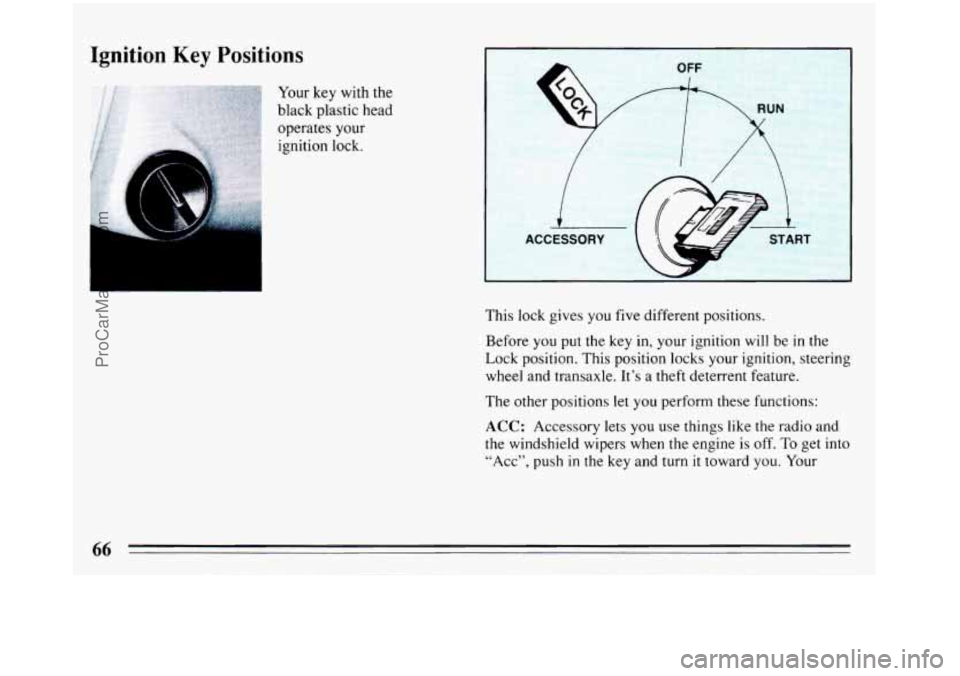
Ignition Key Positions
I ACCESSORY
This lock gives you five different positions.
Before you put the key in, your ignition will be in the
Lock position. This position locks your ignition, steering
wheel and transaxle. It’s a theft deterrent feature.
The other positions let
you perform these functions:
ACC: Accessory lets you use things like the radio and
the windshield wipers when the engine is off.
To get into
“Acc”, push
in the key and turn it toward you. Your
66
ProCarManuals.com
Page 69 of 308
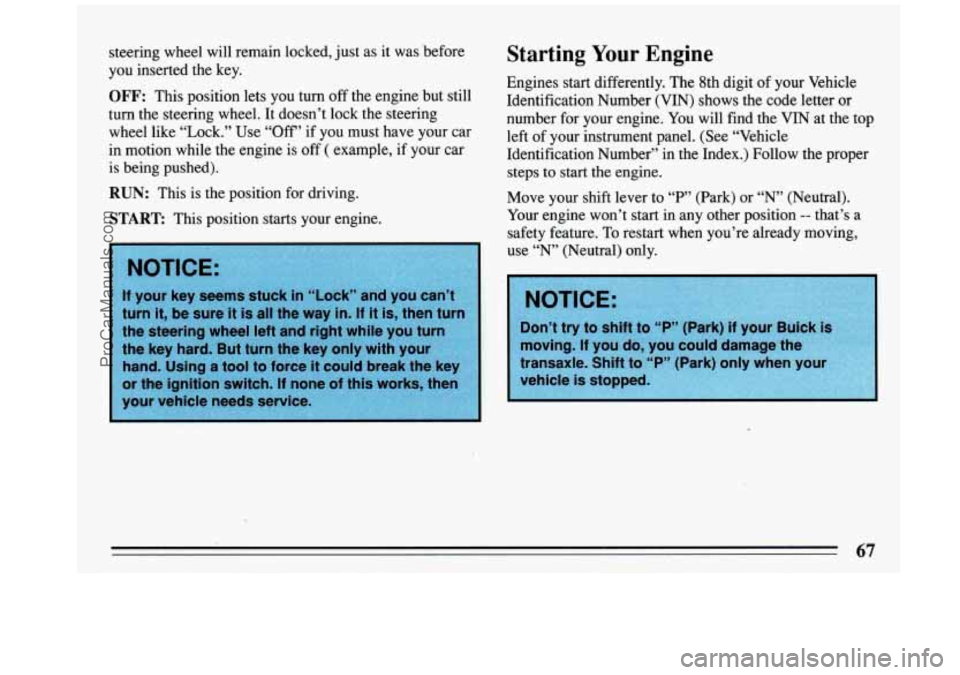
steering wheel will remain locked, just as it was before Starting Your Engine
you inserted the key.
turn the steering wheel. It doesn’t lock the steering number for your engine. You will find the
VIN at the top
in motion while the engine is
off ( example, if your car Identification Number” in the Index.) Follow the proper
is being pushed). steps to start the engine.
Engines start
differently. The 8th digit of your Vehicle
OFF:’ This position lets YOU turn Off the engine but Still
Identification Number (VIN) shows the code letter or
wheel like “Lock.” Use “Off’ if
YOU must have your car
left of your instrument panel. (See ‘‘Vehicle
RUN: This is the position for driving.
START: This position starts your engine. Move your shift lever to
“F”’ (Park)
or “N’ (Neutral).
Your engine won’t start in any other position
-- that’s a
safety feature. To restart when you’re already moving,
use
“N’ (Neutral) only.
Don’t try to shift t
moving. If you do,
transaxle. Shift to ... . -
67
ProCarManuals.com
Page 70 of 308
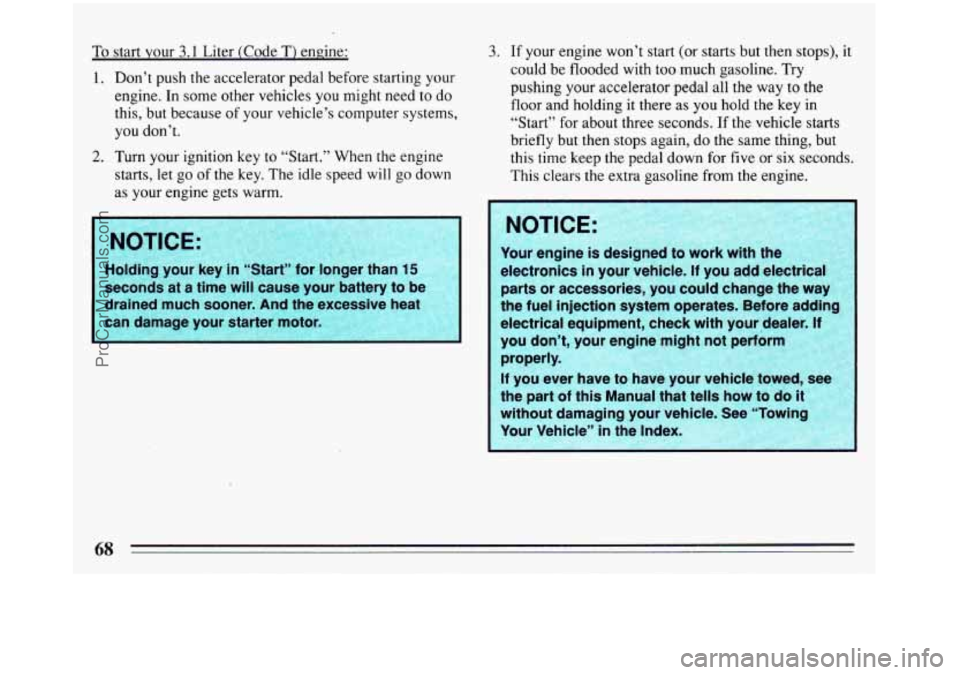
To start your 3.1 Liter (Code T) engine:
1. Don’t push
the accelerator pedal before starting your
engine. In some other vehicles you might need to do
this, but because of your vehicle’s computer systems,
you don’t.
starts, let
go of the key. The idle speed will go down
as your engine gets warm.
2. Turn your ignition key to “Start.” When the engine
omng your Key In “Start” for longer tna
seconds at a time will cause your battery to
t
drained much sooner. And the excessive hear
3. If your engine won’t start (or starts but then stops), it
could be flooded with too much gasoline. Try
pushing your accelerator pedal all the
way to the
floor and holding it there
as you hold the key in
“Start” for about three seconds. If the vehicle starts
briefly but then stops again, do
the same thing, but
this time keep the pedal down for five
or six seconds.
This clears the extra gasoline from the engine.
[ electronics in your vehicle. If you add electrical
parts or accessories, you could change the way
the fuel injection system operates. Before adding
electrical equipment, check with your dealer.
1-
you don’t, your engine might not perforn
properly.
If you ever have to have your vehicle towed, see
the part
of this Manual that tells how to do it
without damaging your vehicle. See “Towing
Your Vehicle” in the Index.
4
-$,.-q*+&< ..,-. >%--:* ..“I)“:.. , .--..:<::.,: m.v;,,, ,‘‘Tmy, ““,u, .; ::x,.* ..,, L, W“ . , ~’‘&&‘, ’~=:.*>:** . .. l\l_ $p;Y-.T@ b
68
ProCarManuals.com